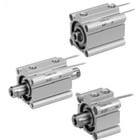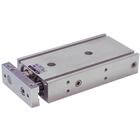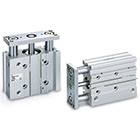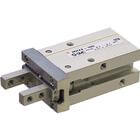

25A Linear Actuator
Basic linear air cylinders are used to provide straight-line, in/out linear movement for a variety of applications. Available as single acting (spring extend or spring return actuators) and double acting styles with single rod or double rod configurations, non-rotating, and precision non-rotating models.
Actuator body styles include crimped, round, or tie rod. Single acting air cylinders develop thrust in one direction and have spring return mechanism, which lowers air consumption compared with the equivalent size of double acting air cylinders. Using a double acting air cylinder, air pressure may be alternately applied to provide force in both directions.
The 25A- series variations are designed using materals compatible with secondary battery applications and are able to be used in low dew point environments. The variations eliminate copper (Cu) and zinc (Zn) material where possible, making them compatible with secondary battery manufacturing for electronics, automotive, and other vehicle types.

Compact Cylinder
Compact cylinders are condensed versions of basic pneumatic cylinders ideal for cylinder applications where saving space and energy is a concern. They are used to provide straight-line, in/out linear movement for a variety of applications.
The 25A- series variations are designed using material compatible with secondary battery applications and are able to be used in low dew point environments. The variaitons eliminate copper (Cu) and zinc (Zn) material where possible, making them compatible with secondary battery manufacturing for electronics, automotive, and other vehicle types.

Guide Cylinder
Guided cylinders utilize guide rods mounted parallel to the piston rod to provide stable, non-rotating, high side load performance. SMC offers dual rod, heavy duty, and precision actuator models. Like rodless cylinders, SMC guide rod cylinders reduce rod bending, piston bending, and uneven seal wear. Low profile guided actuator series are available for restrictive space limitations.
The 25A- series variations are designed using material compatible with secondary battery applications and are able to be used in low dew point environments. The variations eliminate copper (Cu) and zinc (Zn) material where possible, making them compatible with secondary battery manufacturing for electronics, automotive, and other vehicle types.

Compact Guide Cylinders
Compact guide cylinders incorporate compact cylinders with linear guides. These are ideal for guided cylinder applications where saving space and energy is a concern. Guided cylinders utilize guide rods mounted parallel to the piston rod to provide stable, non-rotating, high side load performance.
The 25A- series variations are designed using material compatible with secondary battery applications and are able to be used in low dew point environments. The variations eliminate copper (Cu) and zinc (Zn) material where possible, making them compatible with secondary battery manufacturing for electronics, automotive, and other vehicle types.

Air Grippers
Air cylinders and pneumatic actuators can support automation by enhancing productivity, increasing throughput, and improving worker safety. The 25A- series variations are designed using materials compatible with secondary battery applications, and are able to be used in low dew point environments. These actuators range from linear, guided, rodless, locking, clamp, and stopper styles, and are available with inch and metric dimensions, and as NFPA and ISO Standards. The line also includes related products such as shock absorbers and joints, also compatible with secondary battery applications.

Rotary Actuators
Rotary actuators come in two types: Rack & Pinion and Vane styles. When the application calls for rotational motion less than one revolution, rotary cylinders can mount right at the equipment joint without taking up space with long stroke lengths, which would be required to do the same job with a linear cylinder. SMC's pneumatic rotary actuator units can achieve arc lengths of 90°, 180°, 190°, or even 270°, depending on the configuration.
The 25A- series variations are designed using material compatible with secondary battery applications and are able to be used in low dew point environments. The variations eliminate copper (Cu) and zinc (Zn) material where possible, making them compatible with secondary battery manufacturing for electronics, automotive, and other vehicle types.

Rodless Cylinders/Table Cylinders
Rodless cylinder differ from basic air cylinders in that no piston rod extends outside the cylinder body. Instead, the internal piston is connected to an external carriage, by means of a magnetic or mechanical coupling system.
The 25A- series variations are designed using material compatible with secondary battery applications and are able to be used in low dew point environments. The variations eliminate copper (Cu) and zinc (Zn) material where possible, making them compatible with secondary battery manufacturing for electronics, automotive, and other vehicle types.

Cylinders with Lock/Heavy Duty Stopper Cylinders
Cylinders with lock and heavy-duty stopper cylinders are ideal for drop prevention applications in which air pressure can be lost, or for use on conveyor lines or other applications requiring an external stopping device.
The 25A- series variations are designed using material compatible with secondary battery applications and are able to be used in low dew point environments. The variations eliminate copper (Cu) and zinc (Zn) material where possible, making them compatible with secondary battery manufacturing for electronics, automotive, and other vehicle types.

Related Products
SMC also offers a large selection of accessory products to further complement our abundant line of cylinder products. These include rod clevises, mounting brackets, and aligmnent couplers for attachment. To control speed wer offer shock absorbers, quick exhausts, and flow controls in a wide variety of sizes and configurators.
The 25A- series variations are designed using material compatible with secondary battery applications and are able to be used in low dew point environments. The variations eliminate copper (Cu) and zinc (Zn) material where possible, making them compatible with secondary battery manufacturing for electronics, automotive, and other vehicle types.